Main Building, The University of Hong Kong
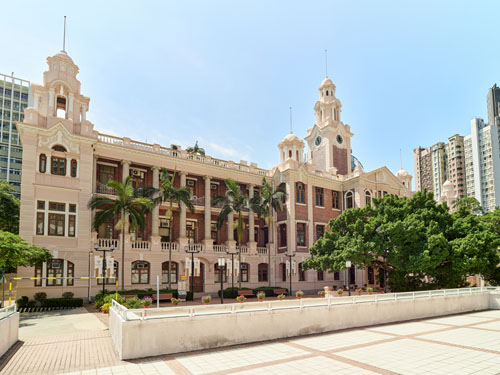
The Main Building is the oldest structure on The University of Hong Kong Main Campus. Construction began in 1910 and was completed in 1912. Sir Hormusjee Mody, a distinguished Parsi businessman and philanthropist in Hong Kong, donated the cost of the building. It has been widely recognised for more than a century as an iconic monument of tertiary education in Hong Kong.
The Main Building was designed by Alfred Bryer of Leigh & Orange, a major architectural firm in Asia. It was designed with exuberant neo-classical features while at the same time demonstrating originality with a series of local adaptive elements. This three-storey red-brick building supported by granite columns of the Ionic order is designed symmetrically around the central axis of the clock tower and features pairs of turrets at both ends of the principal facade. Pediments surmount the entrance portico and the elevations of the east and west wings.
The extensive use of fair-faced red bricks has symbolic significance as it references Britain’s “red-brick universities” which are cladded with bricks instead of granite, limestone, or sandstone. As a humble building material, in contrast to dressed stone, the use of red bricks is indicative of affordable and outwardly democratic institutions. The building’s open verandahs reflect the adaptation of a Western-style building to Hong Kong’s subtropical climate.
The Main Building originally housed all the faculties of HKU, including Arts, Engineering, and Medicine, as well as lecture rooms, a library, administrative offices, and even a clinic and temporary student hostel. Dr Sun Yat-sen delivered a speech at the Great Hall on 20 February 1923. In his speech, he mentioned both Hong Kong and HKU as his intellectual birthplace. During the Battle of Hong Kong in December 1941, the building was converted into a University Relief Hospital to treat both the war-wounded and patients from Queen Mary Hospital. Parts of the building were severely damaged and badly looted during the war and the Japanese Occupation period. The roof timber of the Great Hall was taken down as fuel. University classes were suspended during the war and were not resumed here until October 1946, when the restoration works, begun in late 1945 had been completed.
Originally, the Main Building had a footprint that resembled the Chinese character “日” (literally “sun”), with the Great Hall established in the middle and sandwiched by two courtyards. In the 1950s, the building was extended with an addition of two new courtyards and a further wing at the south, creating the current footprint resembling the Chinese character “田” (literally “field”). These additions, led by Professor Gordon Brown, the founding Dean of the then newly established Faculty of Architecture, followed the architectural language and building materials of the original design.
In 1956, the Great Hall was renamed Loke Yew Hall in memory of Dr Loke Yew, an early benefactor of HKU. It has been a venue for hosting important academic and social events of the University, such as degree-awarding congregations and high-table dinners.
The exterior of the Main Building of The University of Hong Kong was declared a monument on 15 June 1984.
Remark: This site is now marked by the Dr Sun Yat-sen Historical Trail. (A memorial artwork installed at Bonham Road)
Hung Hing Ying Building, The University of Hong Kong
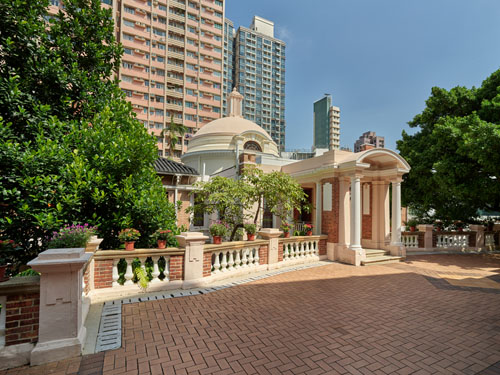
The Hung Hing Ying Building was constructed with financial support from Sir Catchick Paul Chater, a businessman and Honorary Treasurer of The University of Hong Kong, Professor Gregory Paul Jordan, Acting Vice-Chancellor, and Professor Cades Alfred Middleton Smith, Dean of Engineering. It was officially opened by the then Governor, Sir Reginald Stubbs, in February 1919. Originally designed as the Union Building, it accommodated the Hong Kong University Students’ Union from 1919 to 1946. After the Second World War, the building was used for administrative purposes, housing the Registry and the Office of the Bursar and Secretary to the University Council, and was named the Administration Building. In 1974, it was converted into the Senior Common Room for the academic and senior administrative staff of HKU. In 1986, the building was named after the late businessman Mr Hung Hing Ying, in recognition of his and his family’s donations to HKU. Now, it accommodates the Development and Alumni Affairs Office and the HKU Foundation Chamber, etc.
Designed by Little, Adams and Wood, the Hung Hing Ying Building is a two-storey building in red bricks with wooden trusses. Its design follows the dictates of Neo-classism, an appropriate style given its proximity to the Main Building.
The central dome structure, or rotunda, adorned by a roof lantern in the middle, with ornamental windows and a moulded cornice, is the most impressive element. Two rectangular blocks project on each side as wings. The north facade, facing Bonham Road, where the original main entrance was located, has a portico at the centre and a verandah at both sides on the lower floor, with decorative metal railings on the upper floor. On the south elevation facing the Main Building, there is an extended portico with a segmental arched pediment which follows the curvature of the dome. As seen in other campus buildings, the Chinese pitched roofs are laid with double layered pan-and-roll tiling.
The exterior of Hung Hing Ying Building was declared a monument on 15 September 1995.
Fung Ping Shan Building, The University of Hong Kong
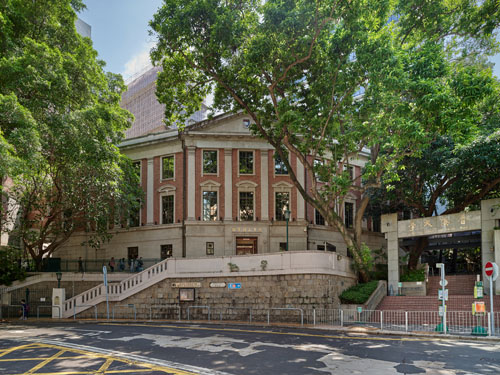
Mr Fung Ping Shan, an entrepreneur who co-founded the Bank of East Asia, wrote a letter to Sir William Hornell, the fourth Vice-Chancellor of The University of Hong Kong, in 1929, expressing his wishes to donate $100,000 for constructing a Chinese library for HKU. After further discussions with the University, Mr Fung Ping Shan agreed to increase the donation and be responsible for the cost of stationery, lightings, fans, furniture and bookshelves, etc., for the library. The construction work of the library (currently the Fung Ping Shan Building) finally began in 1931 and was completed in 1932. The building was named to commemorate the entrepreneur’s generosity. The purpose of the library was to support the newly-founded School of Chinese by collecting books related to Chinese Studies, with a focus on arts, culture, history and literature. Since that time, Fung Ping Shan Library has served not only HKU and the Hong Kong community but also scholars from different parts of the world.
During the Battle of Hong Kong in December 1941, the building was converted into the University Relief Hospital to treat the war-wounded and patients from Queen Mary Hospital. In 1953, the Museum of Chinese Art and Archaeology was established, with exhibitions being held in one of the rooms of the Fung Ping Shan Library. In 1962, the growing collections of the Fung Ping Shan Library were transferred to the newly constructed Main Library of the University to cater for the needs of students and scholars. The library building was converted into the Fung Ping Shan Museum and was officially opened in 1964. Since its beginning, the museum has focused on collecting and exhibiting Chinese antiquities such as bronzes, ceramics, paintings, and pottery, with objectives that align with the teaching and promotion of Chinese art and culture.
The museum was renamed the University Museum and Art Gallery in 1994. In 1996 an adjacent new wing, named the T. T. Tsui Building, was opened with a linking path connecting with Fung Ping Shan Building.
Designed by Leigh and Orange, the Fung Ping Shan Building is a three-storey red-brick building articulated by evenly distributed light-coloured decorative features, including pilasters, window architraves, pediments and a moulded cornice and parapet on its main facade. The building’s symmetrical fan-shaped plan includes an atrium in the middle and wings for side rooms. The atrium features a two-storey gallery supported on octagonal columns, and lit by a prominent skylight.
The exterior of Fung Ping Shan Building was declared a monument on 16 November 2018.
Tang Chi Ngong Building, The University of Hong Kong
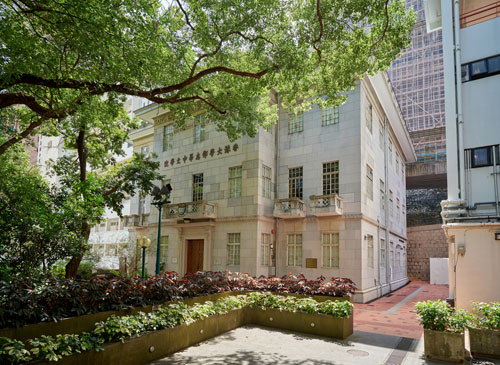
The Tang Chi Ngong Building was funded by the philanthropist Mr Tang Chi Ngong and designed to house the University’s School of Chinese, to promote the development of Chinese classics, history, philosophy, literature and translation. The building was officially opened by Sir William Peel, the then Governor of Hong Kong, on 28 September 1931. For 43 years, the School attracted students, professors, and scholars who were dedicated to the field. Starting from the 1975-76 academic year, the building was used by the Department of Education. In 1982, the Centre of Asian Studies (established in 1952 as the Institute of Oriental Studies) moved to the building, where it remained until 2012. At present, the building serves as the Jao Tsung-I Petite Ecole, a place for displaying the art and artefacts of the late Professor Jao Tsung-I, a revered artist and scholar who worked in the building between 1952 and 1968.
The Tang Chi Ngong Building which overlooks Bonham Road from its position on sloping ground, shows aspects of classicism and Art Deco. The three-storey, flat-roofed building is symmetrical in elevation, with its exterior finished with Shanghai plaster. Although restrained in decoration, the front elevation displays such classically-inspired features as Doric-style mouldings, the use of triglyphs and metopes in the entrance dentil cornice, and a horizontal band of Greek key-pattern fretwork between the ground and first floors. Five balconies, one centrally-placed as part of the building’s frontispiece and two on each side of the front facade, enliven ample windows and seem to provide ceremonial access to the outside. Decorative metal grillwork lightens the balcony balustrades and echoes the pattern on the panels of the main door. The flagpole on the roof, positioned centrally on a low pediment, shows the influence of Art Deco, a popular style at the time the building was constructed. The use of the letter “V” in place of “U” as in “VNIVERSITY” can be found on the front facade, on the plaques inside the building which commemorate its opening and at the Building’s gateway on Bonham Road, etc. The two letters are interchangeable in Latin and this reflects a common practice at the time when the building was constructed.
The exterior of Tang Chi Ngong Building was declared a monument on 15 September 1995.
Eliot Hall, The University of Hong Kong
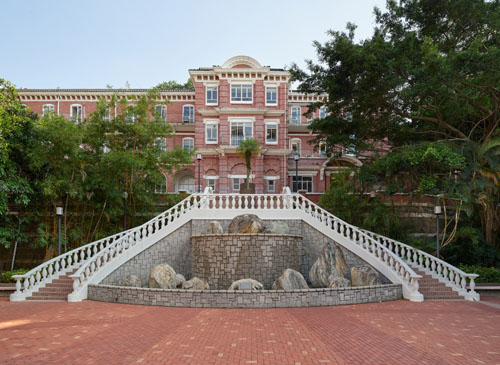
Eliot Hall was the second purpose-built student residential hall under the direct management of The University of Hong Kong, and still survives on the Main Campus. Along with May Hall, two affiliated hostels (i.e. St. John’s Hall and Morrison Hall), and Lugard Hall, the five halls could accommodate up to 270 students by the end of 1915. Eliot Hall was named after the first Vice-Chancellor of HKU, Sir Charles Eliot, and was opened in 1914.
During the Battle of Hong Kong in December 1941, Eliot Hall was converted into the University Relief Hospital to treat the war-wounded and patients from Queen Mary Hospital. After the war, Eliot Hall was reopened in 1946, and was converted into a gymnasium in 1956 and renovated as a male student residential hall in 1963.
In June 1966, a prolonged period of torrential rain caused a massive landslide on an adjacent slope at the east side of Eliot Hall. Eliot Hall was evacuated immediately for extensive repair. Students were relocated temporarily at Lugard Hall and other residential halls. The warden’s quarters at the east end of Eliot Hall had to be demolished. In 1969, the University combined the three halls into one large residential unit named Old Halls and renamed the three halls as Lugard, Eliot and May Wings.
The Lugard Wing was demolished in 1992 for campus development (the site is currently part of the Chong Yuet Ming Amenities Centre and Chong Yuet Ming Chemistry Building), while Eliot Wing was reassigned its original name - Eliot Hall.
Although the Eliot Hall has been converted into university offices and teaching facilities, its original use as a student residence speaks to the continuing hall culture of HKU. It also reflects HKU’s vision of nurturing well-rounded students.
The design of Eliot Hall and the adjacent May Hall is similar, and their sitting on terraces creates an impressive ensemble. It is a three-storey red-brick building designed by Denison, Ram and Gibbs, a local Hong Kong architectural firm. The façades are decorated with an intriguing vocabulary of architectural elements, including curved pediments over entrance doorways, rusticated columns, Doric capitals, and cornices. Balconies with metal balustrades can be found on both front and rear elevations. Such visual richness reflects the Edwardian fascination with classicism. As a contrast to the red brick walls, Chinese-style glazed ceramic air grilles are found on the front elevation. The pitched, double-tiled Chinese roof reflects the sensible integration of aspects of traditional Chinese architecture with imported architectural styles.
The exterior of Eliot Hall was declared a monument on 16 November 2018.
May Hall, The University of Hong Kong
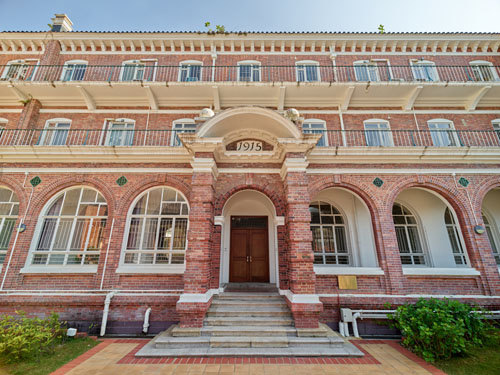
May Hall was the third purpose-built student residential hall under the direct management of The University of Hong Kong, and still survives on the Main Campus. Along with Eliot Hall, two affiliated hostels (i.e. St. John’s Hall and Morrison Hall), and Lugard Hall, the five halls could accommodate up to 270 students by the end of 1915. May Hall was named after the second Chancellor of HKU and the fifteenth Governor of Hong Kong, Sir Francis Henry May, and was opened in 1915.
During the Battle of Hong Kong in December 1941, May Hall served as the main residence for medical staff and overseas students. On New Year’s Day 1942, a secret graduation ceremony was held at May Hall, and wartime degrees were granted to 14 medical students who had taken and passed their final examinations at the time of the Japanese invasion. After the war, May Hall was reopened on 1 January 1948.
In June 1966, a prolonged period of torrential rain caused a massive landslide on an adjacent slope at the east side of May Hall. May Hall was evacuated immediately for extensive repair. Students were relocated temporarily at Lugard Hall and other residential halls. The warden’s quarters at the east end of May Hall had to be demolished. In 1969, the University combined the three halls into one large residential unit named Old Halls and renamed the three halls as Lugard, Eliot and May Wings.
The Lugard Wing was demolished in 1992 for campus development (the site is currently part of the Chong Yuet Ming Amenities Centre and Chong Yuet Ming Chemistry Building), while May Wing was reassigned its original name - May Hall.
Although the May Hall has been converted into university offices and teaching facilities, its original use as student residence speaks to the continuing hall culture of HKU. It also reflects HKU’s vision of nurturing well-rounded students.
The design of May Hall and the adjacent Eliot Hall is similar, and their sitting on terraces creates an impressive ensemble. It is a three-storey red-brick building designed by Denison, Ram and Gibbs, a local Hong Kong architectural firm. The facades are decorated with an intriguing vocabulary of architectural elements, including curved pediments over entrance doorways, rusticated columns, Doric capitals, and cornices. Balconies with metal balustrades can be found on both front and rear elevations. Such visual richness reflects the Edwardian fascination with classicism. As a contrast to the red brick walls, Chinese-style glazed ceramic air grilles are found on the front elevation. The pitched, double-tiled Chinese roof reflects the sensible integration of aspects of traditional Chinese architecture with imported architectural styles.
The exterior of May Hall was declared a monument on 16 November 2018.
University Hall, The University of Hong Kong
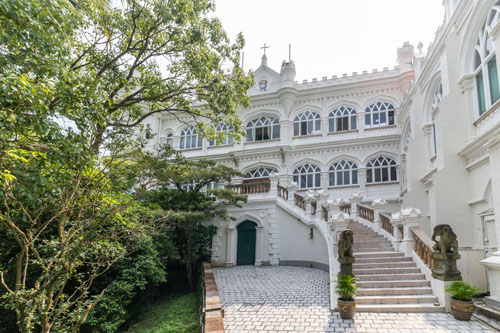
University Hall is the oldest building owned by The University of Hong Kong. It was built around 1861 by Scottish businessman Douglas Lapraik as his headquarters and residence, and named “Douglas Castle”. The building was sold to French Society of Foreign Missions in 1894. The society undertook repairs and addition works to the building. Accommodation for the clergy, as well as a chapel, crypt, and printing house were built. The building was renamed “Nazareth”. After the Second World War, the activities of French Mission diminished considerably, and Nazareth was given up in 1953. At the time, as a result of increased demand, HKU was looking for residential facilities for students and staff members to the south of Pok Fu Lam. HKU acquired the “castle” for use as an undergraduate residential hall in 1954. In September 1956, Nazareth was renamed “University Hall”, and became a residential hall for male students.
University Hall is a three-storey building which blends Gothic and Tudor architectural features. On the building’s exterior, there are verandahs with Tudor arches on the first and second floors, parapets and pinnacles on the roof, and corner towers. A granite staircase leads to the first floor of the dormitory block. A pair of mysterious animal statues stand at the foot of the staircase, in Chinese called “四不像” (literally means “neither fish nor fowl”). There is a well-established story that students who touch them would fail their examinations.
Inside the building, a cast iron spiral staircase, made in Paris, connects all three floors. The chapel, which now serves as the Dining Hall, has a tied timber beam roof providing support for the pitched construction; Chinese tiles are used to cover the roof. Gothic windows with traceries and a rose window are other important architectural features in the chapel. The Common Room below the chapel was once a crypt. Here, massive columns, bold imposts, and sturdy ribbed vaults support the loading of the chapel above and provide a serene and dignified atmosphere.
The exterior of University Hall was declared a monument on 15 September 1995.
Bungalow and Workmen’s Quarters, West Point Filters
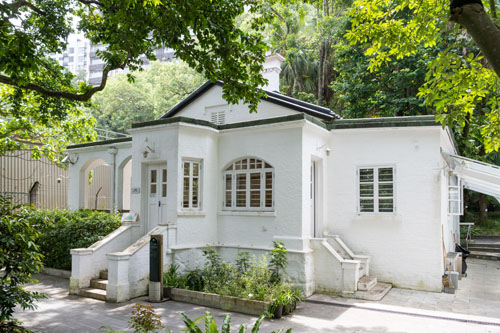
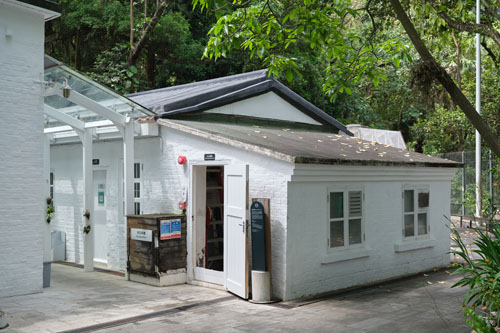
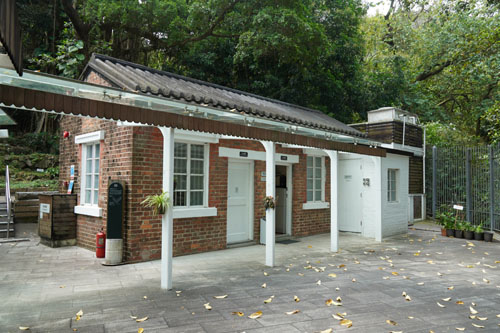
West Point Filters
According to historic documents and maps, the West Point Filters were originally called the “Pokfulam Filter Beds”. When completed and put into operation in the 1890s, the facility was equipped with four filter beds, their filtration materials consisting of layers of coarse broken stones, stone cubes, coarse sand and fine sand. In 1903, two more filter beds were added. The bungalow and two workmen’s quarters are what remains of the historic waterworks complex of the West Point Filters. In 2008, the three buildings were transferred to the Environmental Protection Department and The University of Hong Kong, and the complex was renovated and converted into the Lung Fu Shan Environmental Education Centre.
Bungalow
The Bungalow of the West Point Filters, first constructed in the 1890s, served as the Watchman’s House for the West Point Filters. The building has been used as government quarters, the last household moving out in 2006.
The Bungalow has a unique character amongst the buildings of the West Point Filters. It is a single-storey structure that belongs to a building type influenced by the Indian bungalow, which, in its modified form, became an especially popular housing type in Britain during the late nineteenth century. The L-shaped verandah at the north and east elevations is atypical, demonstrating the adaptability of the housing type to local conditions.
The Bungalow’s masonry foundation is made of local granite, while the building itself was built of bricks. Ventilation openings provide for air circulation, an important function, given Hong Kong’s humidity and the threat of termite infestation. The main part of the roof is pitched and laid with double-layered Chinese pan-and-roll tiles. The chimney indicates that the Bungalow was equipped with fireplace to keep the house warm in cold weather.
The Bungalow of the West Point Filters was accorded a Grade 1 status by the Antiquities Advisory Board on 21 December 2010.
Workmen’s Quarters
The two Workmen’s Quarters were constructed at a later period than the Bungalow, probably between the 1890s and the first half of the twentieth century. In the past, they provided accommodation for Chinese workers. They are both single-storey pitched-roof brick buildings with Chinese double-layered pan-and-roll tiles.
The one at the east, currently painted white, was originally intended to be an extension of the Bungalow, accommodating its kitchen and toilets while also serving as quarters for Chinese workers.
The one further to the west is in fair-faced red brick laid in Flemish bond. The alternating stretchers and headers provide the strength required for structural walls. The building housed the workmen’s quarters and a kitchen for Chinese workers.
The two Workmen’s Quarters of the West Point Filters were accorded Grade 2 status by the Antiquities Advisory Board on 18 December 2009.
Senior Staff Quarters, Elliot Pumping Station and Filters
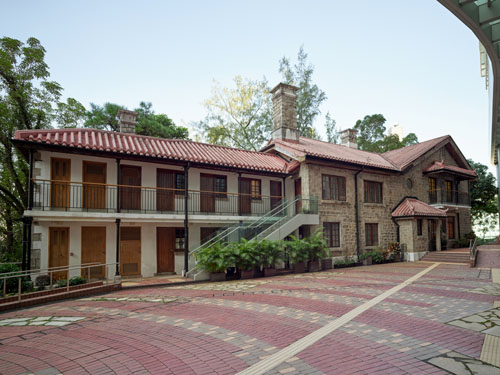
To meet the increasing demand for water at the western end of Hong Kong Island, construction of new waterworks was scheduled for as early as the 1910s, the period of The University of Hong Kong’s decade of expansion. A suitable location was finally identified at the site of the former Elliot Battery alongside Pok Fu Lam Road, which had been surrendered by the British Army in 1914. The construction of the Elliot Pumping Station and Filters started in the same year and was completed in 1919.
However, as time passed and with the wider review of water supply arrangement, the water treatment facilities of the Elliot Pumping Station and Filters finally ceased operation in 1993. With the expansion of HKU in 2012, the site was included as part of the Centennial Campus development proposal.
The two-storey Senior Staff Quarters of the Elliot Pumping Station and Filters was built in 1925 as quarters for site managers. It is an excellent example of the fusion of the Western Arts and Crafts style and Chinese architectural characteristics. Locally-quarried, rough-honed granite is used for both the walls and the chimneys. The French windows and balcony on the primary elevation intend to fully utilise nature and to provide more immediate access from the interior to the exterior. Similar to other local British buildings, the pitched roofs use Chinese pan-and-roll tiles. Also in the Chinese style are the distinctive “horned” ends to the hip ridges, which are found on the roofs of the porch and balcony.
Originally, the interior layout of each floor was largely identical. On the east side, there was a spacious four-roomed flat with fireplaces for senior staff members. Either a verandah or balcony provided sweeping views of the harbour to the north – or hill views to the south. Rooms at the adjoining servants’ quarters on the west were much smaller. There were separate staircases for senior staff and servants to access the spaces.
The Senior Staff Quarters is now known as the Run Run Shaw Heritage House, and since 2013, it has been used by Hong Kong University Press as a bookshop and office.
The Senior Staff Quarters of the Elliot Pumping Station and Filters was accorded a Grade 2 status by the Antiquities Advisory Board on 18 December 2009.
Workmen's Quarters, Elliot Pumping Station and Filters
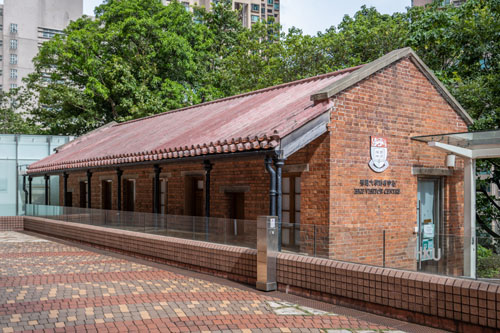
To meet the increasing demand for water at the western end of Hong Kong Island, construction of new waterworks was scheduled for as early as the 1910s, the period of The University of Hong Kong’s decade of expansion. A suitable location was finally identified at the site of the former Elliot Battery alongside Pok Fu Lam Road, which had been surrendered by the British Army in 1914. The construction of the Elliot Pumping Station and Filters started in the same year and was completed in 1919.
However, as time passed and with the wider review of water supply arrangement, the water treatment facilities of the Elliot Pumping Station and Filters finally ceased operation in 1993. With the expansion of HKU in 2012, the site was included as part of the Centennial Campus development proposal.
The Workmen’s Quarters of the Elliot Pumping Station and Filters was built between 1918 and 1919 as quarters for the Chinese staff. The one-storey red brick structure with a rectangular plan was designed to be a practical building, providing basic living accommodation. It comprised a “coolies’ room”, a “watchman’s room” and an office, together with associated bathrooms, kitchens and latrine facilities. The verandah on the south elevation is an Anglo-Indian feature. Its timber rafters are embedded in the brick wall on one end and supported by a plate resting on cast-iron columns on the other. The roof of the verandah is a seamless extension of the main pitched roof, which is laid with double-layered, Chinese pan-and-roll tiles, an indication of local adaptation. This type of design for small-scale staff quarters was common in Hong Kong during the 1910s and 1920s.
The Workmen’s Quarters is now known as HKU Visitor Centre, which was opened in 2014.
The Workmen’s Quarters of the Elliot Pumping Station and Filters was accorded a Grade 3 status by the Antiquities Advisory Board on 22 January 2010.
Treatment Works Building, Elliot Pumping Station and Filters
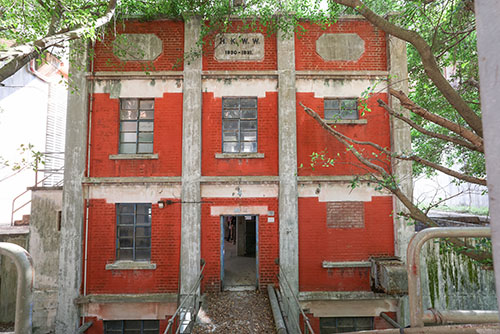
To meet the increasing demand for water at the western end of Hong Kong Island, construction of new waterworks was scheduled for as early as the 1910s, the period of The University of Hong Kong’s decade of expansion. A suitable location was finally identified at the site of the former Elliot Battery alongside Pok Fu Lam Road, which had been surrendered by the British Army in 1914. The construction of the Elliot Pumping Station and Filters started in the same year and was completed in 1919.
However, as time passed and with the wider review of water supply arrangement, the water treatment facilities of the Elliot Pumping Station and Filters finally ceased operation in 1993. With the expansion of HKU in 2012, the site was included as part of the Centennial Campus development proposal.
The Treatment Works Building of Elliot Pumping Station and Filters was constructed between 1930 and 1931 to supplement the operation of the Aberdeen Valley Water Scheme. Built as a filtration plant, the Treatment Works Building aimed at increasing the speed and capacity of the filtration system by mechanical processes and the dosing of chemicals. Chemicals, such as sulphate of alumina, lime and chlorine, were added to the water during the process for coagulation and sterilisation to enhance the drinking water quality.
The building is a three-storey Chemical House with a two-storey operating gallery. A row of filter beds extends along each side of the operating gallery. As a utilitarian reinforced-concrete structure, the regular framing of columns and beams coupled with red-brick infill panels are appealing. Decorative panels adorn the roof parapet, with the central panel at the front elevation incised with “H.K.W.W. 1930-1931”, indicating the period during which this building was constructed.
Although the building is no longer in service, the original equipment, including pipes, pumps, and valves, is still intact. Visitors are able to appreciate the building from a landscaped platform that spans the site.
The Treatment Works Building of the Elliot Pumping Station and Filters was accorded a Grade 3 status by the Antiquities Advisory Board on 22 January 2010.